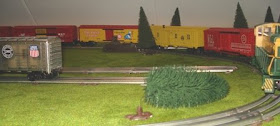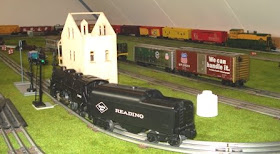


About a month ago, I received a beautiful Weaver FA-2 Alco diesel engine in Union Pacific livery from Northern Saskatchewan. Although produced in 1990, the windows and horns were still not glued on yet. After it stood on the tracks and received some AC-current the lights lit up and the motor made a snorring sound, b

ut the engine did not move.


After dissembling the hood, a missing gear wheel was directly

appearent. After inspecting the box a small fragment of a plastic gear wheel was found.
Based on this fragment a new 8-teeth gear wheel from brass was made by drilling a center 4 mm hole. Then a circle was drawn on 3 mm distance of the hole with a ring and with high-school triangle 4 lines through the center and 45 degrees apart where drawn. On the eight positions where the circle crossed the line small 1.5 mm holes were drilled and afterwards the rough gear wheel was cut out of the brass plate. After sanding and soldering and sanding, the new gear wheel was mounted on the main drive rod, but unfortunately the motor did not run good. The chain tension was too high and consequently the torsion was too high.
In order to reduce the chain tension 1 mm was sanded from the plastic positioning plate for both main drive rods. The mounting holes for this plate were enlarged and after re-assembly the chain could move much more easily. The a special spacer was made from a K&S brass pipe of 4 mm internal diameter and 3 mm width. This helped to position the upper gear wheel precisly over the bottom gear wheel.
Now it finely runs! I must acknowledge my local Lionel train friend for giving me the

repair suggestions that

proved to be the right ones. The engine runs on my 027 layout, but does not like the Lionel 027 switches, because it touches the switch-house with the lower middle hood when it runs over the curved track of the switch. Furthermore, the couplers can not remain centered on 027 track, meaning that they will derail the first car connected in a 027 curve. This can be circumvented with a elastic rubber band over the open couplers, but it is not nice. What is nice of this engine is complete skirt: and not two single parts where the light shine through.




























